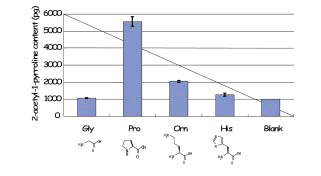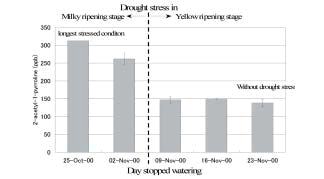Formation of flavor compound in aromatic rice and its fluctuations with drought stress
Description
[Objectives]
With consumer demand for rice surging, farmers throughout the world face substantial pressure to increase productivity while maintaining the quality of their product. Such pressure is particularly severe for farmers cultivating Khao Dawk Mali 105, a major aromatic rice variety usually marketed as "Jasmine," in Northeast Thailand, where drought-stricken sandy soils and other constraints have caused infertility and restricted sufficient cultivation. What is more, cultivation conditions and postharvest practices are compromising the aromatic quality of the rice.
2-acetyl-1-pyrroline, a compound having a "popcorn"-like flavor, is a characteristic flavor component of aromatic rice, and has a lower odor threshold (less than 0.1 ppb in water) than other volatile compounds found in aromatic rice varieties. This compound has also been isolated and identified from pandan (Pandanus amalyrofolys Roxb.) plant leaves and popcorn, and contributes to the aroma of roast beef and wheat and rye bread crusts. There have been no reports thus far elucidating the formation of 2-acetyl-1-pyrroline in aromatic rice varieties, yet formation of this compound in cocoa fermented products and baked products such as breads have been reported. In bread this compound is formed from ornithine and triose phosphates during baking through the Strecker degradation of ornithine. In cocoa, this compound is produced from both L-proline and L-ornithine by Bacillus cereus during fermentation.
[Results]
The formation of these compounds was investigated using a stable isotope dilution method and tracer analysis with 15N amino acids to determine the structure of the precursor (Fig. 1). Analysis confirmed that 2- acetyl-1-pyrroline formed at normal temperatures in the aerial part of aromatic rice, and that L-proline was the nitrogen precursor (Fig. 2). Storage tests also indicated that this compound in aromatic rice kernels can exist as a complex within the hydrophobic region of crystalline starch. These results suggested that certain pre-harvest factors control the quality of aromatic rice, particularly aroma. It was therefore hypothesized that osmotic stress and nitrogen fertilizer application would increase L-proline concentration in rice kernels during ripening. Researchers tested these factors on Khao Dawk Mali 105 and found that osmotic stress during the milky ripening stage increased 2-acetyl-1-pyrroline content, whereas stress after the yellow ripening stage did not. Experiments on nitrogen fertilizer application indicated that application slightly increased 2-acetyl-1-pyrroline content (Fig. 3). These results indicate the possibility of controlling the quality of aromatic rice during cultivation, particularly through ripening and postharvest practices.
Figure, table
-
Fig. 1. Effects of amino acid addition to rice seedlings on 2-acetyl-l-pyrroline formation. When proline (Pro) was added to the solution for rice seedlings, 2-acetyl-1-pyrroline increased the concentration by more than 3-fold in comparison to the control. Addition of glycine (Gly) and histidine (His) did not increase the content in rice seedlings. -
Fig. 2. Possible pathway for 2-acetyl-l-pyrroline formation from proline. Dots show nitrogen in the pyrrolidine ring on proline, and squares show the carbonyl carbon on proline. Carbonyl carbon was not derived from proline, although the nitrogen source was proline. -
Fig. 3. Drought stress induced 2-acetyl-1-pyrroline content when rice was in milky ripening stage, though the stress in yellow ripening stage did not affect the content as the result of pot-based experiment of Thai aromatic variety Khao Dawk Mali 105.
- Affiliation
-
Japan International Research Center for Agricultural Sciences Food Science and Technology Division
- Classification
-
Technical A
- Term of research
-
FY2002 (FY2001-2002)
- Responsible researcher
-
YOSHIHASHI Tadashi ( Food Science and Technology Division )
KABAKI Nobuyuki ( NARO Agricultural Research Center )
NGUYEN Huong T.T. ( JIRCAS Visiting Research Fellowship Program )
INATOMI Hideo ( Meiji University )
- ほか
- Publication, etc.
-
Yoshihashi, T., Nguyen, T. T. H. and Inatomi, H. (2002): Precursors of 2-acetyl-1-pyrroline, a potent flavor compound of an aromatic rice variety. Journal of Agricultural and Food Chemistry, 50(7), 2001-2004.
- Japanese PDF
-
2002_16_A3_ja.pdf855.91 KB
- English PDF
-
2002_16_A4_en.pdf60.01 KB



